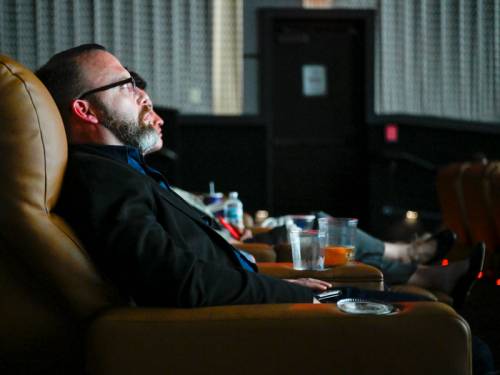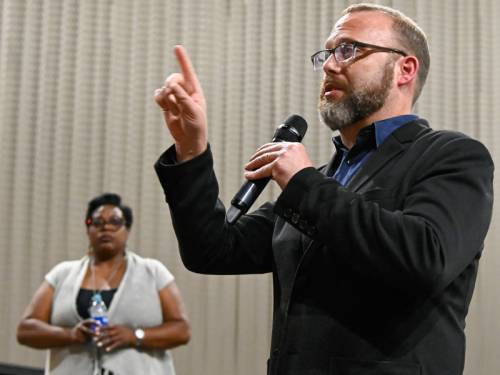Presbyterian Disaster Assistance film plays in Flint-area theaters after world premiere
By Rich Copley | Presbyterian News Service
BIRCH RUN, Michigan — Lisa Horne recalled the first time she heard people in Flint, Michigan, talking about switching the city’s water supply from Detroit to the Flint River.
“I said, ‘They’re not going to switch to the Flint water,’ ” Horne said. “Everybody knows — and I’m not a biologist, I’m not a scientist — but everybody knows the Flint water is nothing but industrial. … They would not do that because that doesn’t make any common sense for our community.

Director David Barnhart watches his documentary “Flint: The Poisoning of an American City” at the Emagine Theatres in Birch Run, Michigan. Photo by Rich Copley.
“I remember when they did it, I was in shock. And I remember saying, ‘What are they trying to do, kill people with that water?’ But I had no clue what was going to happen.”
People died and many more became extremely ill in the city’s 5-year-old water crisis that was still making headlines last week as the Presbyterian Disaster Assistance-produced documentary “Flint: The Poisoning of an American City” had its world premiere and opened in a chain of Michigan movie theaters.
Horne spoke at a screening Friday night at the Emagine Theatre in Birch Run, a half-hour north of Flint. The night before, the documentary premiered in Flint to an audience of more than 600 people at the Capitol Theatre downtown.
A more intimate and extremely engaged audience greeted the Friday evening screening, which was followed with a discussion led by Horne and the film’s director, David Barnhart.
“I loved it. It was very informative,” Mary Lazar said of the film. Lazar has been a Flint resident for more than 30 years who said she has spent more than $60,000 replacing lead pipes in her 1927 home.
As “Flint,” from Presbyterian Disaster Assistance’s Story Ministry, details, the water crisis emerged from a combination of a water source polluted by decades of industrial waste, aging infrastructure and poor decision-making by government officials, particularly a series of emergency managers appointed by then-Gov. Rick Snyder after the city fell into a financial crisis. That put the city’s decision-making in the hands of an unelected manager instead of local elected officials, including the mayor.

Lisa Horne, director of community ministry at First Presbyterian Church of Flint, helped lead a discussion after a screening of the Presbyterian Disaster Assistance Story Ministry documentary, “Flint: The Poisoning of an American City” at the Emagine Theatres in Birch Run, Michigan. Photo by Rich Copley.
“And as I said in the film, if you had asked the people, it would have been a big, fat, ‘No,’ ” Horne said of the switch to the Flint River.
Horne, the director of community ministry at First Presbyterian Church of Flint, is one of a number of Flint residents and experts interviewed in the movie, and her sentiment was echoed by Friday’s audience.
Lazar said that citizens had no voice in the decisions that led to the crisis.
While people in the audience were familiar with the crisis — some intimately — a few found surprises, such as the fact that residents were still being required to pay a monthly water bill for the tainted water or risk losing their homes and potentially their children, as unpaid water bills are attached to property taxes.
One person in the audience said that a fund should be started to help the people who owe for their water bills. Horne said it was her prayer that the bills would be forgiven.

Director David Barnhart and Lisa Horne, director of community ministry at First Presbyterian Church of Flint, helped lead a discussion after a screening of the Presbyterian Disaster Assistance Story Ministry documentary, “Flint: The Poisoning of an American City” at the Emagine Theatres in Birch Run, Michigan. Photo by Rich Copley.
There was also discussion of other emerging water contaminants, including PFAS (man-made chemicals) in products such as waterproof clothing, stain-resistant fabrics, and firefighting foam that has been found in drinking water around the world, including a number of Michigan communities.
Michael Drops, who works in industrial wastewater management, said PFAS is widespread, as are other potential contaminants. But lead is a particular hazard, as he said, “every city in the Midwest has lead-based service pipes.”
Drops told Barnhart that he rarely goes out at night but made an exception for the Flint documentary.
“It gave a lot of information from the residents’ perspective,” he said of the film. “It was very insightful and put together well, without putting the blame on anyone.”
Barnhart said the conversation that took place in the Birch Run theater was exactly the type of exchange he hopes to inspire with the film.
“We hope this film can be a resource for community conversations and be a catalyst for wider engagement around these issues,” Barnhart said. “All of this can be overwhelming, and the issues are so widespread and systemic, but we are not powerless, and are definitely not alone.
“Cultivating wider circles of community engagement and action can be a part of the movement for change. Story and film can be a resource for that process.”
Lazar said she appreciated the portrayal of Flint residents with dignity and respect, something that she says has not always come across in national media coverage of the city.
“They want to keep us down, but no matter how hard they try, we will rise,” she said. “This is a resilient community.”
Presbyterian Disaster Assistance’s Story Ministry is made possible by your generous contributions to One Great Hour of Sharing.
Read more
PDA ‘Flint’ documentary premieres in city still enduring its water crisis
Flint film aims to tell truth of the water crisis with residents’ voices
Presbyterian Disaster Assistance films inspire conversation and action
![]() You may freely reuse and distribute this article in its entirety for non-commercial purposes in any medium. Please include author attribution, photography credits, and a link to the original article. This work is licensed under a Creative Commons Attribution-NonCommercial-NoDeratives 4.0 International License.
You may freely reuse and distribute this article in its entirety for non-commercial purposes in any medium. Please include author attribution, photography credits, and a link to the original article. This work is licensed under a Creative Commons Attribution-NonCommercial-NoDeratives 4.0 International License.
Categories: Advocacy & Social Justice, Peace & Justice
Tags: clean water, compassion peace and justice, documentary, drinking water, flint, pda, water, water crisis
Ministries: Presbyterian Disaster Assistance, Compassion, Peace and Justice